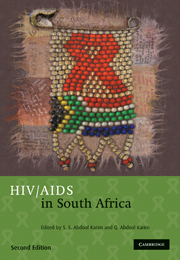Book contents
- Frontmatter
- Contents
- List of Contributors
- Foreword: Peter Piot
- Foreword: Nelson R Mandela
- Acknowledgements
- Section 1 Birth of a rapidly growing epidemic
- Section 2 The virus, the human host and their interactions
- Section 3 HIV risk factors and prevention strategiess
- 9 Reducing sexual risk behaviours: theory and research, successes and challenges
- 10 Barrier methods
- 11 Mother-to-child transmission (MTCT) of HIV-1
- 12 Sexually transmitted infections
- 13 Safe blood supplies
- 14 Intravenous drug use in South Africa
- 15 Positive prevention interventions
- 16 New prevention strategies under development and investigation
- Section 4 Focal groups for understanding the HIV epidemic
- Section 5 The impact of AIDS
- Section 6 Treating HIV
- Section 7 What does the future hold?
- Index
14 - Intravenous drug use in South Africa
Published online by Cambridge University Press: 07 September 2011
- Frontmatter
- Contents
- List of Contributors
- Foreword: Peter Piot
- Foreword: Nelson R Mandela
- Acknowledgements
- Section 1 Birth of a rapidly growing epidemic
- Section 2 The virus, the human host and their interactions
- Section 3 HIV risk factors and prevention strategiess
- 9 Reducing sexual risk behaviours: theory and research, successes and challenges
- 10 Barrier methods
- 11 Mother-to-child transmission (MTCT) of HIV-1
- 12 Sexually transmitted infections
- 13 Safe blood supplies
- 14 Intravenous drug use in South Africa
- 15 Positive prevention interventions
- 16 New prevention strategies under development and investigation
- Section 4 Focal groups for understanding the HIV epidemic
- Section 5 The impact of AIDS
- Section 6 Treating HIV
- Section 7 What does the future hold?
- Index
Summary
SHARING NEEDLES FOR INJECTING drugs is a potent vector for the transmission of blood-borne viral diseases because infected blood is injected directly into the user's system. The more damaging trends in global drug abuse did not emerge in South Africa until the mid-1990s because of apartheid isolation.
Now, intravenous drug use is a small, but growing trend. Heroin is the drug most commonly associated with injecting drug practices, but, until recently, has been little used in South Africa. However, there has been an escalation in arrests for heroin since 1997 and treatment demand for heroin is known to be rising. Most current South African heroin users ‘chase’ their drug: vaporising it and then inhaling. But variations in quality of heroin may result in increased injection use of the drug. In addition, there has been a growth in heroin use in communities where hiv rates are high, and needle sharing could provide the vehicle for infection to spread to communities less affected in the past. The relationship between sex workers, intravenous drug use and hiv infection is a potentially potent one in increasing drug-related infections. The recent explosion of methamphetamine use, particularly in the Western Cape, could also affect transmission in unexpected ways, as the drug can also be injected. The possibility of needle exchange programmes to mitigate these effects in South Africa is explored.
Because of its isolation during the apartheid era, South Africa was for many years spared the more damaging global trends in substance abuse.
- Type
- Chapter
- Information
- HIV/AIDS in South Africa , pp. 240 - 249Publisher: Cambridge University PressPrint publication year: 2010
- 1
- Cited by

